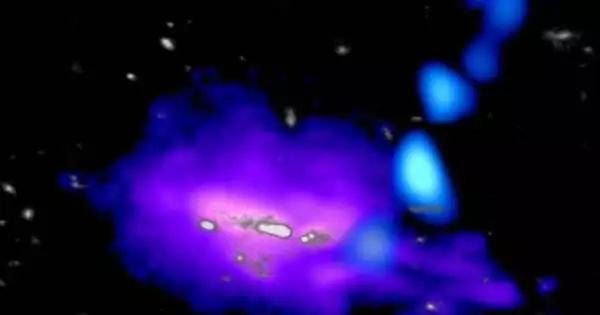International space researchers have discovered a “cold stream” of molecular gas outside of a galaxy, supporting the idea that galaxies form stars. The group used the array of radio telescopes at the Atacama Large Millimeter Array (ALMA) to concentrate on the stream and learn more about its characteristics for their study, which was published in the journal Science. In the same journal issue, Caitlin Casey, an astronomer at the University of Texas, published a perspective article on the team’s work.
Cold streams of gases are thought to form in space and occasionally fall into galaxies, where they fuel the star-forming process, according to theories put forth by space scientists for a long time. But because these streams are cold and have such low resolution, it has been challenging to demonstrate the validity of such theories. Additionally, it is difficult to zoom in to see them due to their large size. Nevertheless, in spite of these challenges, the team behind this new endeavor discovered proof that a stream like this was feeding a galaxy called 4C 41.17.
The research team had to assemble ALMA’s radio satellite array as closely as they could in order to find the stream. This made it possible to see the stars in the stream while also taking in the stream’s overall appearance. Their measurements put its length at 500,000 light years. While they were unable to determine the composition of the stream or its source, the researchers believe that it is primarily composed of carbon. The stream was falling into the galaxy, as had been predicted by theories, which is what they could see.
Returning to ALMA and possibly using the Very Large Array in New Mexico, the researchers intend to continue their investigation of the stream in an effort to find carbon monoxide, which has also been theorized to be present. Additionally, they want to learn more about the stream’s characteristics, which might point them in the direction of similar streams. They also intend to investigate the physics of the accretion that produces stars inside galaxies.
More information: Bjorn H. C. Emonts, A cosmic stream of atomic carbon gas connected to a massive radio galaxy at redshift 3.8, Science (2023). DOI: 10.1126/science.abh2150. www.science.org/doi/10.1126/science.abh2150
Caitlin M. Casey, Streams of cold cosmic fuel for the galaxies, Science (2023). DOI: 10.1126/science.adh1663. www.science.org/doi/10.1126/science.adh1663





